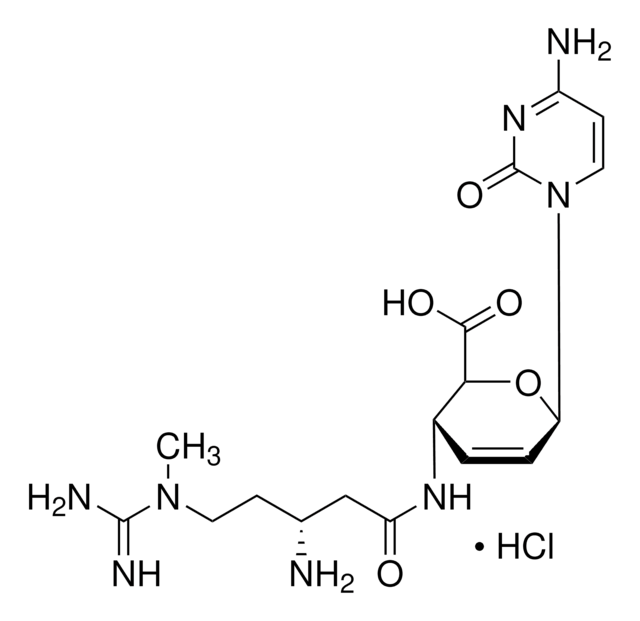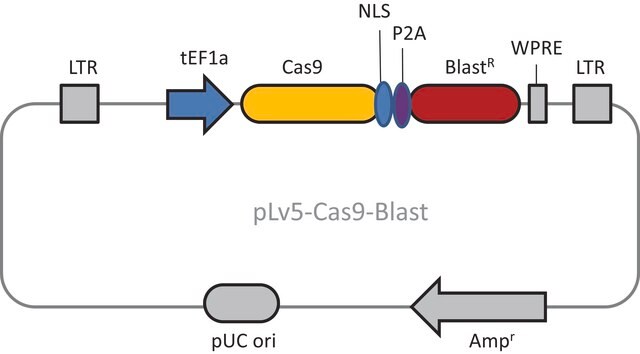SBR00022
Blasticidin S Ready Made Solution
10 mg/mL (20 mM HEPES), 0.22 μm filtered
About This Item
Prodotti consigliati
Livello qualitativo
Sterilità
0.22 μm filtered
Saggio
≥98% (HPLC)
Stato
liquid
Concentrazione
10 mg/mL (20 mM HEPES)
Colore
colorless to faint yellow
Spettro attività antibiotica
fungi
Modalità d’azione
protein synthesis | interferes
Temperatura di conservazione
−20°C
Stringa SMILE
CN(CCC(CC(=O)NC1C=CC(OC1C(=O)O)N2C=CC(=NC2=O)N)N)C(=N)N.Cl
InChI
1S/C17H26N8O5.ClH/c1-24(16(20)21)6-4-9(18)8-12(26)22-10-2-3-13(30-14(10)15(27)28)25-7-5-11(19)23-17(25)29;/h2-3,5,7,9-10,13-14H,4,6,8,18H2,1H3,(H3,20,21)(H,22,26)(H,27,28)(H2,19,23,29);1H
YQXYQOXRCNEATG-UHFFFAOYSA-N
Descrizione generale
In research, Blasticidin S has become a valuable tool, notably as a marker for strain manipulations. Recent applications involve the use of Blasticidin S as a selection agent for cells carrying plasmids conferring blasticidin resistance. The resistance is mediated by the blasticidin S deaminase genes (bsr from Bacillus cereus or BSD from Aspergillus terreus). These genes produce enzymes that catalyze the hydrolytic deamination of the cytosine moiety in blasticidin S, leading to the formation of a non-toxic deaminohydroxy derivative. This resistance mechanism is crucial in various studies involving genetic manipulations and selections in cell biology and biochemical research.
Applicazioni
- studies to have fungicidal properties and prevents rice blast disease.
- used as a selection agent for transformed cells that contain the resistance genes bls, bsr, or bsd. Blasticidin S has been used to select HEK293-T cells with TLR-2 constructs and HEK-D5 cells.
- used to study protein synthesis at the level of peptide bond formation.
Azioni biochim/fisiol
Antimicrobial Spectrum: Active against mycobacteria, several Gram-positive and Gram-negative bacteria
Caratteristiche e vantaggi
- High-quality antibiotic suitable for multiple research applications
- Ideal for Cell Biology and Biochemical research
Altre note
Avvertenze
Danger
Indicazioni di pericolo
Consigli di prudenza
Classi di pericolo
Acute Tox. 3 Oral
Codice della classe di stoccaggio
6.1D - Non-combustible acute toxic Cat.3 / toxic hazardous materials or hazardous materials causing chronic effects
Classe di pericolosità dell'acqua (WGK)
WGK 1
Punto d’infiammabilità (°F)
Not applicable
Punto d’infiammabilità (°C)
Not applicable
Scegli una delle versioni più recenti:
Possiedi già questo prodotto?
I documenti relativi ai prodotti acquistati recentemente sono disponibili nell’Archivio dei documenti.
I clienti hanno visto anche
Il team dei nostri ricercatori vanta grande esperienza in tutte le aree della ricerca quali Life Science, scienza dei materiali, sintesi chimica, cromatografia, discipline analitiche, ecc..
Contatta l'Assistenza Tecnica.









